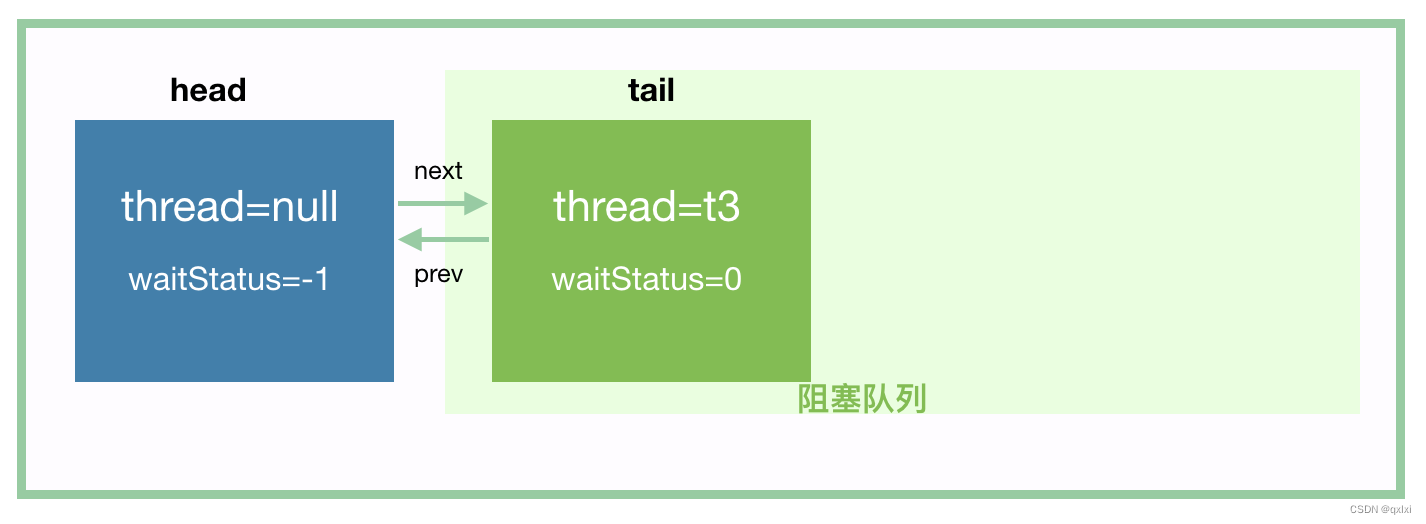【源码解析】从CountDownLatch角度聊聊AQS

使用案例
CountDownLatch的用法是通过构造参数输入需要等待的线程个数,countDown 进行操作,当state=0的时候,阻塞的await线程就可以继续执行任务。
public static void main(String[] args) {
CountDownLatch countDownLatch = new CountDownLatch(2);
Thread t1 = new Thread(() -> {
countDownLatch.countDown();
System.out.println(Thread.currentThread().getName()+ " 线程执行了");
},"t1");
Thread t2 = new Thread(() -> {
countDownLatch.countDown();
System.out.println(Thread.currentThread().getName()+ " 线程执行了");
},"t2");
t1.start();
t2.start();
Thread t3 = new Thread(() -> {
try {
countDownLatch.await();
} catch (InterruptedException e) {
e.printStackTrace();
}
System.out.println(Thread.currentThread().getName()+ " 线程执行了");
},"t3");
Thread t4 = new Thread(() -> {
try {
countDownLatch.await();
} catch (InterruptedException e) {
e.printStackTrace();
}
System.out.println(Thread.currentThread().getName()+ " 线程执行了");
},"t4");
t3.start();
t4.start();
}
构造方法
通过构造参数,可以发现其实内部通过syn进行初始化一个内部对象。实现了AQS。也就是通过构造方法将state设置为对应的数值2
public CountDownLatch(int count) {
if (count < 0) throw new IllegalArgumentException("count < 0");
// 构造一个内部sync
this.sync = new Sync(count);
}
//内部类方法 实现类AQS
private static final class Sync extends AbstractQueuedSynchronizer {}
Sync(int count) {
//继承是AQS类 将当前state 设置为count
setState(count);
}
await
//当state = 0的时候,不阻塞
public void await() throws InterruptedException {
sync.acquireSharedInterruptibly(1);
}
先判断当前线程是否中断,中断直接抛出异常
public final void acquireSharedInterruptibly(int arg)
throws InterruptedException {
//是否中断
if (Thread.interrupted())
throw new InterruptedException();
// 线程等待
if (tryAcquireShared(arg) < 0)
doAcquireSharedInterruptibly(arg);
}
getState() 此时等于2 所以返回-1 进入doAcquireSharedInterruptibly这个逻辑中
// 返回负数 获取锁失败
// 返回0 获取锁成功 不唤醒后续节点
// 返回正数 获取锁成功, 唤醒后续节点
protected int tryAcquireShared(int arg) {
throw new UnsupportedOperationException();
}
// state == 0 锁空闲,直接返回1
protected int tryAcquireShared(int acquires) {
return (getState() == 0) ? 1 : -1;
}
doAcquireSharedInterruptibly的主要作用就是将当前线程封装成一个Node节点。加入到AQS队列中,注意是共享模式
private void doAcquireSharedInterruptibly(int arg)
throws InterruptedException {
// 封装成一个node 加入AQS队列中 共享模式
final Node node = addWaiter(Node.SHARED);
boolean failed = true;
try {
//自选锁
for (;;) {
final Node p = node.predecessor();
if (p == head) {
// state 不等于0 返回-1
int r = tryAcquireShared(arg);
// 第一次不会进入
if (r >= 0) {
// // 2. 这里将唤醒t3的后续节点t4,以此类推,t4被唤醒后,会在t4的await中唤醒t4的后续节点
setHeadAndPropagate(node, r);
// t3节点删除
p.next = null; // help GC
failed = false;
return;
}
}
// 修改前驱节点waitstate = -1 挂起当前线程
if (shouldParkAfterFailedAcquire(p, node) &&
parkAndCheckInterrupt())
throw new InterruptedException();
}
} finally {
if (failed)
cancelAcquire(node);
}
}

tryAcquireShared 返回的是-1 所以 shouldParkAfterFailedAcquire 会将head的waitStatus 设置为-1。然后t3 线程挂起

t4走到这里也会将t3进行waitStaus=-1 然后t4挂起

此时 线程t3 和 t4就等待state 等于0的线程唤醒。
countDown
// 其实就是将state-1
public void countDown() {
sync.releaseShared(1);
}
public final boolean releaseShared(int arg) {
if (tryReleaseShared(arg)) {
doReleaseShared();
return true;
}
return false;
}
protected boolean tryReleaseShared(int releases) {
// Decrement count; signal when transition to zero
// state = 0的时候 才返回true
// 否则就是state -=1
for (;;) {
int c = getState();
if (c == 0)
return false;
int nextc = c-1;
if (compareAndSetState(c, nextc))
return nextc == 0;
}
}
可以看到只有当 tryReleaseShared 返回true 的时候,才会进入到 doReleaseShared的逻辑,也就是state=0, 当进入unparkSuccessor,也就是先唤醒t3线程。
private void doReleaseShared() {
// 自选锁
for (;;) {
Node h = head;
if (h != null && h != tail) {
int ws = h.waitStatus;
// 前面已经将pre节点 设置为-1
if (ws == Node.SIGNAL) {
if (!compareAndSetWaitStatus(h, Node.SIGNAL, 0))
continue; // loop to recheck cases
// 唤醒head的后继节点
unparkSuccessor(h);
}
else if (ws == 0 &&
!compareAndSetWaitStatus(h, 0, Node.PROPAGATE))
continue; // loop on failed CAS
}
if (h == head) // loop if head changed
break;
}
}
int r = tryAcquireShared(arg);
// 第一次不会进入 当state=0 会进入这个方法
if (r >= 0) {
// // 2. 这里将唤醒t3的后续节点t4,以此类推,t4被唤醒后,会在t4的await中唤醒t4的后续节点
setHeadAndPropagate(node, r);
// t3节点删除
p.next = null; // help GC
failed = false;
return;
}
将当前节点t3设置为head节点,唤醒后续的节点。
private void setHeadAndPropagate(Node node, int propagate) {
Node h = head; // Record old head for check below
setHead(node);
// 唤醒后续的节点
if (propagate > 0 || h == null || h.waitStatus < 0 ||
(h = head) == null || h.waitStatus < 0) {
Node s = node.next;
if (s == null || s.isShared())
doReleaseShared();
}
}
private void doReleaseShared() {
// 自选锁
for (;;) {
Node h = head;
if (h != null && h != tail) {
int ws = h.waitStatus;
// 前面已经将pre节点 设置为-1 会将-1的节点都唤醒。
if (ws == Node.SIGNAL) {
if (!compareAndSetWaitStatus(h, Node.SIGNAL, 0))
continue; // loop to recheck cases
// 唤醒head的后继节点
unparkSuccessor(h);
}
else if (ws == 0 &&
!compareAndSetWaitStatus(h, 0, Node.PROPAGATE))
continue; // loop on failed CAS
}
if (h == head) // loop if head changed
break;
}
}
使用场景
多个线程执行等待一个线程执行完毕。以及一个线程等待多个线程执行完毕,就可以组合使用进行等待。
或者一批任务执行的时候,必须全部执行完毕才完成,也是可以的。
总结
总体上来说,CownDownLatch的原理大概如下。
1.通过构造参数设置state的个数
2.使用await 将state的线程添加到aqs队列中并且waitStatus = -1
3.当countDown() 将state=0的时候,唤醒aqs中的第一个线程,之后该线程唤醒之后的所有线程。
本文来自互联网用户投稿,该文观点仅代表作者本人,不代表本站立场。本站仅提供信息存储空间服务,不拥有所有权,不承担相关法律责任。 如若内容造成侵权/违法违规/事实不符,请联系我的编程经验分享网邮箱:veading@qq.com进行投诉反馈,一经查实,立即删除!